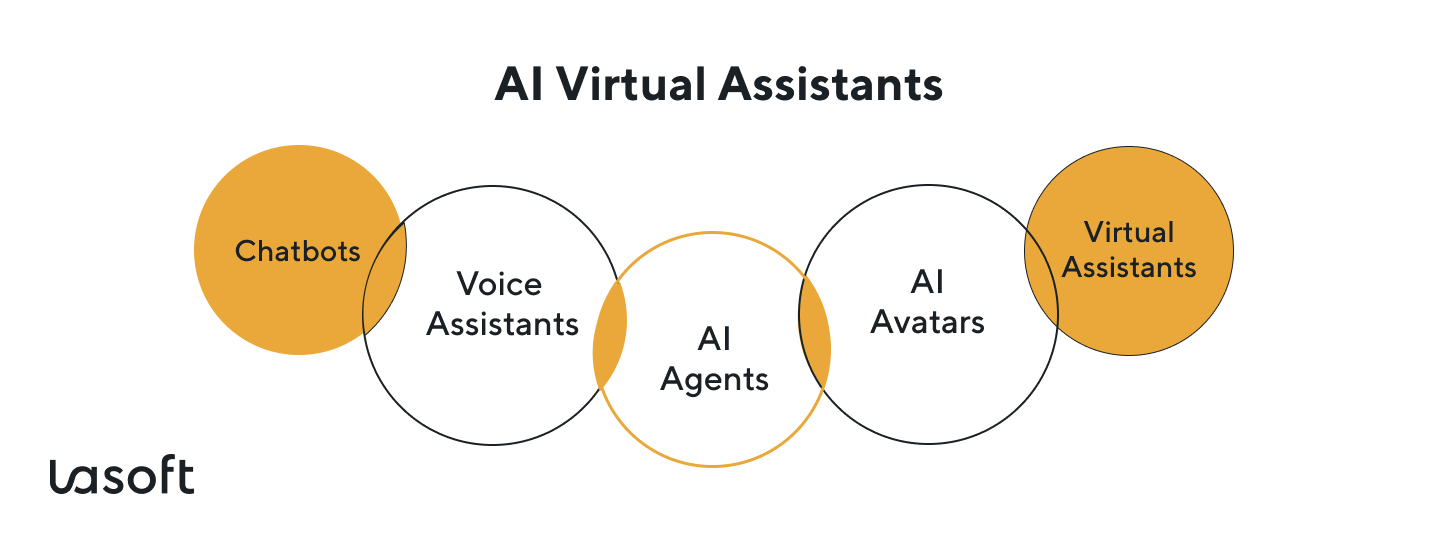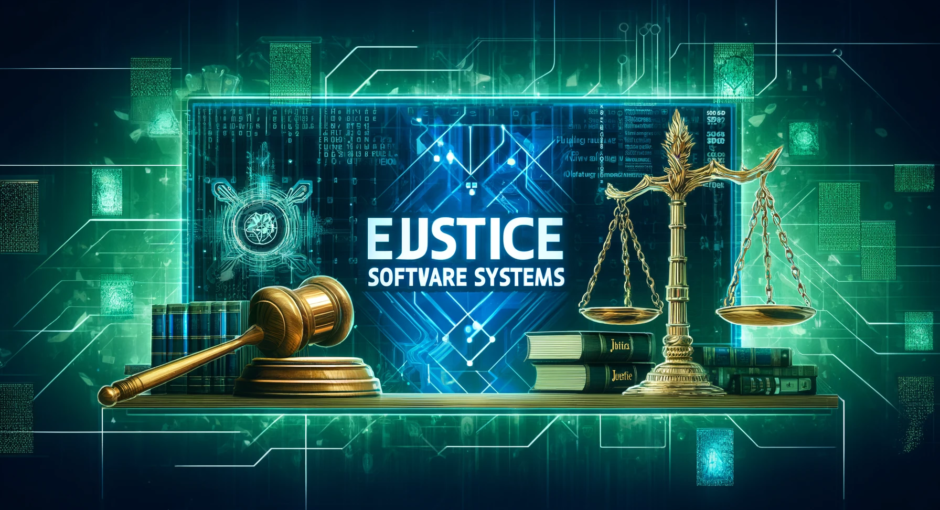AI assistants, as advanced software programs that use artificial intelligence, have become indispensable tools for people and companies who want to make their work more productive.
These smart assistants offer many features that can change the way companies interact with customers or employees, complete daily tasks, and improve many workflows. As reported by Statista, there were over 8.4 billion active digital voice assistants worldwide in 2024, surpassing the global population. At their core, developers are creating artificial intelligence assistance to understand and respond to human speech. They use natural language processing (NLP), which helps machines to understand, interpret, and create human language. With NLP, AI assistants can also read text, answer questions, follow commands, and even detect emotions. Machine learning works with NLP to improve the capabilities of AI assistants. It examines data sets to find patterns, enabling AI assistants to learn from experience.
Types of AI Assistants
Businesses use AI assistants as versatile tools to enhance productivity, improve and personalize customer experiences, and support specialized tasks across industries. AI assistants and agents automate business workflows and offer a competitive advantage, saving time and money by:
- Automating repetitive tasks;
- Enhancing user experiences through personalized and interactive support;
- Providing data insights and forecasting trends;
- Handling large volumes of queries and processes efficiently.
Development teams help choose the right type of AI assistant or agent, depending on the goals and needs:
Chatbots
Chatbots are AI-powered assistants that interact with users through text-based chat interfaces. You can use them to cover various tasks and get 24/7 support.
- Customer Support: Answering common inquiries, guiding users through processes, and resolving issues that may arise.
- Sales Assistance: Providing product recommendations and addressing pre-sale queries.
- Internal Operations: Assisting employees with quick responses concerning HR or IT-related questions.
Voice Assistants
Voice assistants, like Siri, Google Assistant, and Alexa, respond to voice commands, offer hands-free interaction, and perform tasks such as:
- Setting reminders and alarms.
- Controlling smart home devices.
- Providing weather updates, traffic reports, and general information.
- Managing schedules or sending messages.
AI Avatars
AI avatars are graphical or animated representations of AI assistants, often designed for interactive and visually engaging experiences, making them highly effective for branding and entertainment. Applications include:
- Gaming: Serving as NPCs (non-playable characters) or guides.
- Customer Support: Adding a human-like interface to online interactions.
- Virtual Events: Engaging users in virtual reality environments.
Virtual Assistants
Specialized virtual assistants deliver domain-specific expertise, improving efficiency and accuracy in complex industries and providing expert support in areas such as:
- Healthcare: Assisting with medical diagnoses, patient monitoring, and appointment scheduling.
- Finance: Offering financial portfolio management, investment advice, and fraud detection.
- Education: Providing personalized learning experiences and grading automation.
- Legal: Streamlining contract analysis and ensuring compliance with regulations.
AI Agents for SMBs and Enterprise Applications
AI agents are autonomous systems designed to help businesses with intelligent decisions. They are valuable for companies aiming to optimize operations, reduce costs, and gain a competitive edge by offering such options as:
- Data Analysis: Interpreting complex data sets to provide actionable insights and build a successful business strategy.
- Process Automation: Managing workflows, from supply chain operations to customer or employee onboarding.
- Personalized Marketing: Using customized data to automate targeted campaigns based on user behavior and customer interactions with the digital product.
- Predictive Maintenance: Monitoring systems to predict and prevent equipment failures.

What Does a Custom AI Personal Assistant Bring to Businesses?
AI assistance for businesses refers to integrating AI technologies to streamline operations and unlock new growth opportunities as a strategic tool for various industries. Companies that use AI gain significant competitive advantages and can increase their sales as a result.
| Supply chain management: | AI companion improves inventory management, automatically validates carriers, and negotiates the best rates, saving time and optimizing chat processes. |
| HR and recruitment: | AI-driven algorithms shorten hiring cycles by efficiently identifying candidates whose skills match job requirements. AI assistants help with CV screening, interview scheduling, and onboarding. |
| Retail and e-commerce: | AI-driven chatbots help customers search for products, answer questions, and help with transactions. Recommendation engines suggest personalized products based on individual browsing history and preferences. |
| Real estate: | Artificial intelligence support streamlines property searches using personalized data and manages communication between agents, clients, and owners. |
| Education: | AI tutors provide personalized learning experiences, track student progress, and automate grading. Virtual AI assistants can support teachers with timetables, lesson planning, questionnaires, and resource recommendations. Students can get relevant information and answers to complex questions from the knowledge base. |
| Marketing and sales: | AI technology helps analyze customer data to personalize marketing campaigns, optimize lead generation, and automate email marketing. |
| Healthcare: | AI agents can schedule patient appointments, send reminders, and offer virtual consultations to support patients with helpful information. They also help to analyze medical data and monitor patients’ progress. |
| Hotels and travel Agencies: | Automate booking processes, provide personalized travel recommendations, and manage guest requests through virtual concierges. |
| Cybersecurity: | Identifying and mitigating threats in real-time, automating security protocols, and analyzing user behavior for anomalies. |
| Media and video content: | Personalizing content recommendations, automating video editing, and generating content using AI tools. |
What are Custom AI Assistants vs. General-purpose AI Assistants?
Custom AI assistants work as customized artificial intelligence solutions designed to address specific needs, workflows, and challenges within a particular company or business. Unlike general-purpose AI assistants, which are built for widespread use cases, custom AI assistants integrate seamlessly into a company’s unique processes and workflows, providing personalized and optimized support. Let’s specify the differences between both AI assistants and how they can cover your business needs:
| Key Features | Custom AI Assistants | General-purpose AI Assistants |
| Purpose | Covers specific business needs, problem solving and task execution; | Designed for general use without addressing specific inquiries; |
| Integration | Customization with existing company systems and tools; | Limited customization for integration; |
| Personalize interactions | Highly personalized for industry-specific tasks and workflows; | General functionality for common-known use cases; |
| Management | Managed by the company’s employees, ensuring data security; | Controlled and operated by third-party providers; |
| Insights and outcomes | Evolves depending on training data, the company’s growth and inner changes; | Limited flexibility and adaptability; |
| Data usage | Works with the company’s own data sources for customized insights; | Relies on general datasets and information; |
| Cost effectiveness | Higher upfront investment but long-term ROI; | Lower initial cost but often limited scope and scalability; |
Generative AI capabilities of digital assistants provide valuable support, but a custom-built solution elevates your operations to a higher level. Although developing an “AI companion” requires an upfront investment, the benefits it brings through complex tasks execution, process optimization and efficiency improvements make it a worthwhile and quickly repayable endeavor.
Key Benefits of Using a Custom AI Assistant
Automating Complex and Repetitive Tasks
A custom AI assistant allows you to qualify clients and personalize your offers by taking over time-consuming and repetitive processes. It also helps your human employees to focus on strategic work and improving client’s interaction with your products or services;
Efficiency and Productivity
Business process automation streamlines workflows and eliminates bottlenecks, improving overall operational efficiency and output.
AI experts integrate AI assistants into existing systems, ensuring smooth interaction between AI assistant-Client and AI assistant-Employees without disrupting established workflows.
Scalability and Cost Efficiency
The AI assistant can handle increasing workloads and adapt to a company’s growing needs, optimizing processes and ensuring long-term usability and ROI.
Why LaSoft’s AI Approach Delivers Measurable Business Value
At LaSoft, our AI expertise extends beyond technical implementation; we align AI strategies with your business goals. By building scalable, secure, and performance-driven solutions, we empower companies to:
- Reduce operational costs by automating repetitive processes
- Deliver personalized customer experiences at scale
- Enhance decision-making with predictive insights
- Improve compliance and data security with robust controls
- Accelerate innovation through agile, AI-powered transformation
AI-driven Voice Agent: LaSoft Real-Case Example in Logistics
We’ve got a case where we added a voice mode designed for the logistics company to communicate with dispatchers, truck drivers, brokers, and stakeholders. AI tools manage specific information about upcoming freights, and drivers’ identifications. Leveraging natural language processing and machine learning, the AI-powered agent will handle incoming and outgoing calls, provide shipment details, update contract statuses, and manage key logistics information.
Key Project Components
Data Integration:
The AI assistant integrates seamlessly with existing logistics databases and systems. It uses shipment IDs and MC numbers to pull relevant real-time shipment data, check drivers’ authority, and ensure accuracy and consistency across all operations.
AI Agent Functionality:
Check MC numbers (unique identifier) of the driver,
Real-time updates on active loads,
Provide shipment information,
Terms negotiation support,
Pricing updates,
Real-time updates on active loads,
Updates on shipment statuses in the database in real-time,
user inputs and conversation history etc.
Call Agent Features:
Set up a phone number for agent interaction and ensure smooth call transitions to live representatives when necessary.
A test phone number allows interaction with the AI assistant and then transferring calls to human agents if needed.

How the AI Voice Assistant Works in Logistics
An AI agent connects shippers (companies or individuals who need to transport goods), brokers (who help to match shippers with available carriers), and carriers (trucking companies or independent drivers). AI assistants use advanced technologies such as machine learning, natural language processing, and optimization algorithms to streamline connecting shippers with carriers. It offers a more efficient solution than traditional methods of communication. It helps save working time by confirming the MC#, providing updates on load details, negotiating prices, and informing about requirements for transporting the load. A human agent steps in when the AI agent encounters requests it cannot handle or when price negotiations are required.
| Driver authority and shipment details check | The AI assistant answers a request, “I want to pick up the shipment ID #” and analyzes the database of available shipments. It checks the driver’s MC number to determine whether to proceed with further negotiation regarding price, pickup details, and delivery timelines. |
| Voice-activated load matching | AI gets the user’s request (e.g., “Find a load from Chicago to Atlanta”) and matches it with available shipments in the database, confirming details and providing options. Analyzes available truck lists and schedules, providing users with accurate information on available transport space to help maximize load efficiency. |
| Real-time shipment tracking | Users can ask the question, “Where is my shipment?” and receive up-to-date information on the shipment’s location, estimated time of arrival (ETA), and possible delays. This eliminates the need for multiple phone calls to drivers or dispatchers. |
| Proactive load management | The AI assistant contacts carriers to collect updates on active loads, ensuring brokers have accurate and timely information to share with clients. This feature enhances operational efficiency by reducing manual follow-ups. |
| Save working time | An AI assistant saves hours by checking the driver’s MC number and negotiating prices. It also automates repetitive tasks such as optimizing routes, updating shipment details, and scheduling deliveries. |
| Route optimization and updates | Based on traffic, weather conditions, and road closures, the AI suggests optimal routes for drivers and continuously updates the route during the journey. This information ensures timely deliveries and reduces fuel costs. |
| Dispatching and scheduling | Drivers can request new loads through the AI assistant, which assigns shipments based on availability and confirms pickup and delivery schedules. |
| Fleet management support | Fleet managers can monitor vehicle performance, track fuel usage, and receive alerts for maintenance schedules or safety compliance issues like Hours of Service (HOS) reminders. This helps maintain a reliable fleet and avoid costly breakdowns. |
Why Choose a Professional Software Development Team for Building an AI Assistant
Professional teams have worked in the market for many years and offer expert skills in machine learning frameworks, natural language processing (NLP) libraries, and the latest AI advancements. They develop solutions that give human-like responses, ensuring your AI assistant delivers precise functionality and maintains scalability for future demands. You may be surprised to know that even prompts should be composed correctly to train AI to follow algorithms for completing specific tasks. Clear, context-aware prompts help the AI assistant understand user intentions and provide accurate responses, minimizing misunderstanding and offering correct responses. Structured prompts help the assistant understand nuances and context, producing more precise outputs.
Efficient Use of Resources |
Building an AI assistant requires seamless integration of multiple technologies, such as voice recognition, data processing, and machine learning. A professional team can efficiently select and implement the right technology stack, avoiding unnecessary overhead and ensuring your project stays on budget and timeline. |
Tailored Solutions for Business Goals |
An experienced development team excels in translating your unique business requirements into actionable design and functionality. Whether your AI assistant is for customer support, task automation, or industry-specific needs, they ensure it aligns with your goals and target audience. |
Implementation and Testing |
A robust development team ensures your AI assistant undergoes testing to handle real-world scenarios effectively. These efforts may include simulating various inputs, fine-tuning ML models, and ensuring Android device and Apple device compatibility. |
Post-Deployment Support |
Even after launch, a skilled team provides ongoing support, fine-tuning prompts, updating features, and scaling the solution as your business grows. |
How a Development Team Builds an AI Assistant from Scratch
Step 1: AI Assistant’s Purpose
First, the development team identifies the specific role the assistant will fulfill. Businesses may need personal assistants to manage daily tasks, a customer support chatbot to handle inquiries, or a task automation tool to streamline repetitive processes.
Key questions:
- What problems will the AI assistant solve?
- What tasks will it perform?
- Who is the target audience?
Step 2: The Right Technology Stack
Experts assess the project’s needs to choose suitable NLP, ML, and voice recognition tools.
Popular Technologies:
- NLP Frameworks: spaCy, NLTK, Hugging Face Transformers.
- Machine Learning Libraries: TensorFlow, PyTorch.
- Voice Recognition Tools: Google Speech-to-Text, Amazon Transcribe.
The choice of programming language is equally crucial. Python is often favored for AI development due to its simplicity and robust libraries, while JavaScript is ideal for building interactive web-based assistants.
Step 3: Collect and Prepare Data
Developers gather and prepare data to train the AI assistant effectively. Depending on the assistant’s purpose, this data may include conversations, text documents, audio files, or domain-specific resources.
The team ensures the dataset is diverse, unbiased, and sufficient for accurate training.
Step 4: Train the AI Assistant
Using the prepared data, the team trains the AI assistant with machine learning models. They may leverage pre-trained models and fine-tune them for the specific use case. The team iteratively evaluates the model’s performance and refines it to improve accuracy and relevance.
Metrics such as accuracy, precision, and response time are monitored to ensure the assistant meets performance expectations.
Step 5: Testing and Debugging
Extensive testing is conducted to validate the AI assistant’s performance. The team evaluates:
- Functionality: Ensuring tasks like setting reminders or responding to queries work as intended.
- Usability: Ensuring interactions are intuitive and user-friendly.
- Performance: Testing response times under various conditions.
Step 6: Deployment
Once testing is complete, the assistant is deployed on the chosen platform. The development team ensures the hosting environment is scalable and secure. Developers often use cloud platforms like AWS, Google Cloud, or Azure.
Step 7: Continuous Improvement
Businesses hire professional teams as the development process doesn’t end with deployment. The team continuously monitors the AI assistant’s performance and gathers user feedback to refine its functionality. They may update the training dataset, add new features, and enhance security protocols.



